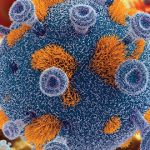Such testing is critical if other signs in the clinical history point to the possibility of HIV. Of the roughly 1.2 million people living in the U.S. with HIV, approximately 13% do not know they are infected.28
2) Collaborate early and often with infectious disease specialists. Especially be aware of potential drug–drug interactions with HIV medications. Notes Dr. Calabrese, “The most important thing to recognize is that the anti-viral therapy for HIV infection is very complex and that any rheumatic disease that will require specific therapy—even if we recommend a short course of glucocorticoids—has to be viewed through the lens of potential drug–drug interactions with the HIV medications.” This is especially important for disease-modifying anti-rheumatic drugs and immunosuppressives, but it is important to at least check for interactions with any medication.
3) When performing a differential for an HIV-positive rheumatology patient, carefully consider the specific context. Dr. Calabrese advises, “The first thing I do is ask, ‘What is the severity and activity of their HIV infection?’ If it is someone who has been well controlled and they have undetectable virus levels for five years, then my consideration is that they probably just have a rheumatic disease that is totally unrelated to HIV. On the other extreme, if this is poorly controlled, early-onset, active HIV infection and they’re immunodepleted, then the differential expands dramatically. Is this an opportunistic infection, is this a weird inflammatory manifestation of HIV infection, or is the case somewhere in between?”

Dr. Walker-Bone
Dr. Walker-Bone also recommends considering the timing of new rheumatologic symptoms with respect to diagnosis, treatment changes, etc.
4) Be measured when diagnosing new rheumatic syndromes in patients who are HIV positive, especially in the absence of a convincing clinical picture. Realize that they may have transiently positive clinical markers, as well as markers that remain elevated, simply as a component of their HIV. In this context, keep IRIS in mind as a possibility in patients who have recently begun HIV therapy.
5) Be aware of the spectrum of HIV-associated rheumatic diagnostic possibilities. Be especially alert to the possibility of avascular necrosis.
Clinicians must maintain a high index of suspicion for avascular necrosis when investigating HIV-positive patients who have joint pain.
Moving Forward
The intersection of rheumatic disease and HIV illness is still a young area worthy of further study. Ultimately, more research will be needed to discover the optimal treatments for these patients and to uncover the pathophysiological connections between these diseases. Disease registries may help make this possible.


